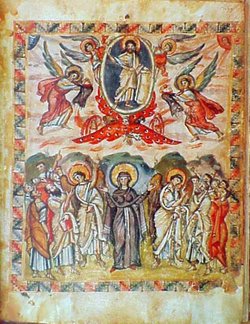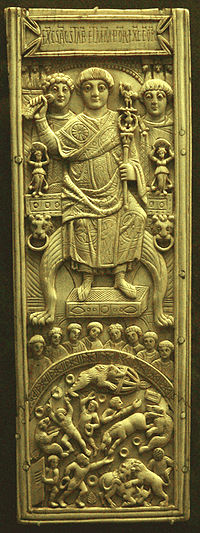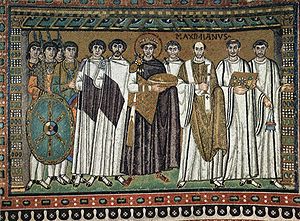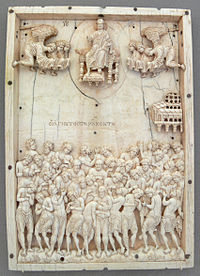- Byzantine art
-
 The most famous of the surviving Byzantine mosaics of the Hagia Sophia in Constantinople - the image of Christ Pantocrator on the walls of the upper southern gallery. Christ is flanked by the Virgin Mary and John the Baptist. The mosaics were made in the 12th century.
The most famous of the surviving Byzantine mosaics of the Hagia Sophia in Constantinople - the image of Christ Pantocrator on the walls of the upper southern gallery. Christ is flanked by the Virgin Mary and John the Baptist. The mosaics were made in the 12th century.
This article is part of the series on: Greek Bronze Age Cycladic art - Minoan art Mycenean art
Art in ancient Greece Archaic Greek art - Classical Greek art
see also: Greco-Buddhist art
Medieval Greece Byzantine art - Macedonian art Post-Byzantine Greece Art in Ottoman Greece - Cretan School Heptanese School
Modern Greece Art in modern Greece - Munich School Byzantine art is the term commonly used to describe the artistic products of the Byzantine Empire from about the 5th century until the Fall of Constantinople in 1453.
The term can also be used for the art of Eastern Orthodox states which were contemporary with the Byzantine Empire and were culturally influenced by it, without actually being part of it (the "Byzantine commonwealth"), such as Bulgaria, Serbia, or Rus and also for the art of the Republic of Venice and Kingdom of Sicily, which had close ties to the Byzantine Empire despite being in other respects part of western European culture. Art produced by Eastern Orthodox Christians living in the Ottoman Empire is often called "post-Byzantine." Certain artistic traditions that originated in the Byzantine Empire, particularly in regard to icon painting and church architecture, are maintained in Greece, Serbia, Bulgaria, Russia and other Eastern Orthodox countries to the present day.
Contents
Introduction
Just as the Byzantine Empire represented the political continuation of the Roman Empire, Byzantine art developed out of the art of the Roman Empire, which was itself profoundly influenced by ancient Greek art. Byzantine art never lost sight of this classical heritage. The Byzantine capital, Constantinople, was adorned with a large number of classical sculptures,[1] although they eventually became an object of some puzzlement for its inhabitants.[2] And indeed, the art produced during the Byzantine Empire, although marked by periodic revivals of a classical aesthetic, was above all marked by the development of a new aesthetic.
The most salient feature of this new aesthetic was its “abstract,” or anti-naturalistic character. If classical art was marked by the attempt to create representations that mimicked reality as closely as possible, Byzantine art seems to have abandoned this attempt in favor of a more symbolic approach.
The nature and causes of this transformation, which largely took place during late antiquity, have been a subject of scholarly debate for centuries.[3] Giorgio Vasari attributed it to a decline in artistic skills and standards, which had in turn been revived by his contemporaries in the Italian Renaissance. Although this point of view has been occasionally revived, most notably by Bernard Berenson,[4] modern scholars tend to take a more positive view of the Byzantine aesthetic. Alois Riegl and Josef Strzygowski, writing in the early 20th century, were above all responsible for the revaluation of late antique art.[5] Riegl saw it as a natural development of pre-existing tendencies in Roman art, whereas Strzygowski viewed it as a product of “oriental” influences. Notable recent contributions to the debate include those of Ernst Kitzinger,[6] who traced a “dialectic” between “abstract" and "Hellenistic” tendencies in late antiquity, and John Onians,[7] who saw an “increase in visual response” in late antiquity, through which a viewer “could look at something which was in twentieth-century terms purely abstract and find it representational.”
In any case, the debate is purely modern: it is clear that most Byzantine viewers did not consider their art to be abstract or unnaturalistic. As Cyril Mango has observed, “our own appreciation of Byzantine art stems largely from the fact that this art is not naturalistic; yet the Byzantines themselves, judging by their extant statements, regarded it as being highly naturalistic and as being directly in the tradition of Phidias, Apelles, and Zeuxis.”[8]
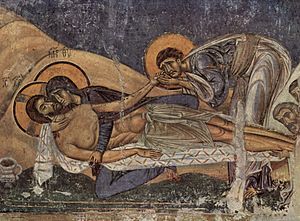 Frescoes in Nerezi near Skopje (1164), with their unique blend of high tragedy, gentle humanity, and homespun realism, anticipate the approach of Giotto and other proto-Renaissance Italian artists.[citation needed]
Frescoes in Nerezi near Skopje (1164), with their unique blend of high tragedy, gentle humanity, and homespun realism, anticipate the approach of Giotto and other proto-Renaissance Italian artists.[citation needed]
The subject matter of monumental Byzantine art was primarily religious and imperial: the two themes are often combined, as in the portraits of later Byzantine emperors that decorated the interior of the sixth-century church of Hagia Sophia in Constantinople. These preoccupations are partly a result of the pious and autocratic nature of Byzantine society, and partly a result of its economic structure: the wealth of the empire was concentrated in the hands of the church and the imperial office, which therefore had the greatest opportunity to undertake monumental artistic commissions.
Religious art was not, however, limited to the monumental decoration of church interiors. One of the most important genres of Byzantine art was the icon, an image of Christ, the Virgin, or a saint, used as an object of veneration in Orthodox churches and private homes alike. Icons were more religious than aesthetic in nature: especially after the end of iconoclasm, they were understood to manifest the unique “presence” of the figure depicted by means of a “likeness” to that figure maintained through carefully maintained canons of representation.[9]
The illumination of manuscripts was another major genre of Byzantine art. The most commonly illustrated texts were religious, both scripture itself (particularly the Psalms) and devotional or theological texts (such as the Ladder of Divine Ascent of John Climacus or the homilies of Gregory of Nazianzus). Secular texts were also illuminated: important examples include the Alexander Romance and the history of John Skylitzes.
The Byzantines inherited the Early Christian distrust of monumental sculpture in religious art, and produced only reliefs, of which very few survivals are anything like life-size, in sharp contrast to the medieval art of the West, where monumental sculpture revived from Carolingian art onwards. Small ivories were also mostly in relief.
“Minor” or “luxury” arts (i.e. ivories, steatites, enamels, jewelry, metalwork, ceramics, etc.) were produced in large number throughout the Byzantine era. Many of these were also religious in nature, although a large number of objects with secular or non-representational decoration were produced: for example, ivories representing themes from classical mythology, and ceramics decorated with figures that may derive from the Akritic epics.
Periods
Early Byzantine art
Two events were of fundamental importance to the development of a unique, Byzantine art. First, the Edict of Milan, issued by the emperors Constantine I and Licinius in 313, allowed for public Christian worship, and led to the development of a monumental, Christian art. Second, the dedication of Constantinople in 330 created a great new artistic centre for the eastern half of the Empire, and a specifically Christian one. Other artistic traditions flourished in rival cities such as Alexandria, Antioch, and Rome, but it was not until all of these cities had fallen - the first two to the Arabs and Rome to the Goths - that Constantinople established its supremacy.
Constantine devoted great effort to the decoration of Constantinople, adorning its public spaces with ancient statuary,[10] and building a forum dominated by a porphyry column that carried a statue of himself.[11] Major Constantinopolitan churches built under Constantine and his son, Constantius II, included the original foundations of Hagia Sophia and the Church of the Holy Apostles.[12]
The next major building campaign in Constantinople was sponsored by Theodosius I. The most important surviving monument of this period is the obelisk and base erected by Theodosius in the Hippodrome.[13] The earliest surviving church in Constantinople is the Basilica of St. John at the Stoudios Monastery, built in the fifth century.[14]
Due to subsequent rebuilding and destruction, relatively few Constantinopolitan monuments of this early period survive. However, the development of monumental early Byzantine art can still be traced through surviving structures in other cities. For example, important early churches are found in Rome (including Santa Sabina and Santa Maria Maggiore),[15] and in Thessaloniki (the Rotunda and the Acheiropoietos Basilica).[16]
A number of important illuminated manuscripts, both sacred and secular, survive from this early period. Classical authors, including Virgil (represented by the Vergilius Vaticanus[17] and the Vergilius Romanus[18]) and Homer (represented by the Ambrosian Iliad), were illustrated with narrative paintings. Illuminated biblical manuscripts of this period survive only in fragments: for example, the Quedlinburg Itala fragment is a small portion of what must have been a lavishly illustrated copy of 1 Kings.[19]
Early Byzantine art was also marked by the cultivation of ivory carving.[20] Ivory diptychs, often elaborately decorated, were issued as gifts by newly appointed consuls.[21] Silver plates were another important form of luxury art:[22] among the most lavish from this period is the Missorium of Theodosius I.[23] Sarcophagi continued to be produced in great numbers.
The Age of Justinian
Significant changes in Byzantine art coincided with the reign of Justinian I (527-565). Justinian devoted much of his reign to reconquering Italy, North Africa and Spain. He also laid the foundations of the imperial absolutism of the Byzantine state, codifying its laws and imposing his religious views on all his subjects by law.[24]
A significant component of Justinian's project of imperial renovation was a massive building program, which was described in a book, the Buildings, written by Justinian's court historian, Procopius.[25] Justinian renovated, rebuilt, or founded anew countless churches within Constantinople, including Hagia Sophia,[26] which had been destroyed during the Nika riots, the Church of the Holy Apostles,[27] and the Church of Saints Sergius and Bacchus.[28] Justinian also built a number of churches and fortifications outside of the imperial capital, including the Monastery of St. Catherine on the Sinai Peninsula,[29] and the Basilica of St. John in Ephesus.[30]
Several major churches of this period were built in the provinces by local bishops in imitation of the new Constantinopolitan foundations. The Basilica of San Vitale in Ravenna, was built by Bishop Maximianus. The decoration of San Vitale includes important mosaics of Justinian and his empress, Theodora, although neither ever visited the church.[31] Also of note is the Euphrasian Basilica in Poreč.[32]
19-20th century archeological discoveries unearthed a large group of Early Byzantine mosaics in the Middle East. The eastern provinces of the Eastern Roman and later the Byzantine Empires inherited a strong artistic tradition from the Late Antiquity. Christian mosaic art flourished in this area from the 4th century onwards. The tradition of making mosaics was carried on in the Umayyad era until the end of the 8th century. The most important surviving examples are the Madaba Map, the mosaics of Mount Nebo, Saint Catherine's Monastery on Mount Sinai and the Church of St Stephen in ancient Kastron Mefaa (now Umm ar-Rasas).
The first fully preserved illuminated biblical manuscripts date to the first half of the sixth century, most notably the Vienna Genesis,[33] the Rossano Gospels,[34] and the Sinope Gospels.[35] The Vienna Dioscurides is a lavishly illustrated botanical treatise, presented as a gift to the Byzantine aristocrat Julia Anicia.[36]
Important ivory sculptures of this period include the Barberini ivory, which probably depicts Justinian himself,[37] and the Archangel ivory in the British Museum.[38] Silver plate continued to be decorated with scenes drawn from classical mythology; for example, a plate preserved in the Cabinet des Médailles, Paris, depicts Hercules wrestling the Nemean lion.
The seventh-century crisis
 Mosaic from the church of Hagios Demetrios in Thessaloniki, late 7th or early 8th century, showing St. Demetrios with donors.
Mosaic from the church of Hagios Demetrios in Thessaloniki, late 7th or early 8th century, showing St. Demetrios with donors.
The Age of Justinian was followed by a political decline, since most of Justinian's conquests were lost and the Empire faced acute crisis with the invasions of the Avars, Slavs, Persians and Arabs in the 7th century. Constantinople was also wracked by religious and political conflict.[39]
The most significant surviving monumental projects of this period were undertaken outside of the imperial capital. The church of Hagios Demetrios in Thessaloniki was rebuilt after a fire in the mid-seventh century. The new sections include mosaics executed in a remarkably abstract style.[40] The church of the Koimesis in Nicaea (present-day Iznik), destroyed in the early 20th century but documented through photographs, demonstrates the simultaneous survival of a more classical style of church decoration.[41] The churches of Rome, still a Byzantine territory in this period, also include important surviving decorative programs, especially Santa Maria Antiqua, Sant'Agnese fuori le mura, and the Chapel of San Venanzio in San Giovanni in Laterano.[42] Byzantine mosaicists probably also contributed to the decoration of the early Umayyad monuments, including the Dome of the Rock in Jerusalem and the Great Mosque of Damascus.[43]
Important works of luxury art from this period include the silver David Plates, produced during the reign of Heraclius, and depicting scenes from the life of the Hebrew king David.[44] The most notable surviving manuscripts are Syriac gospel books, such as the so-called Syriac Bible of Paris.[45] However, the London Canon Tables bear witness to the continuing production of lavish gospel books in Greek.[46]
The period between Justinian and iconoclasm saw major changes in the social and religious roles of images within Byzantium. The veneration of acheiropoieta, or holy images "not made by human hands," became a significant phenomenon, and in some instances these images were credited with saving cities from military assault. By the end of the seventh century, certain images of saints had come to be viewed as "windows" through which one could communicate with the figure depicted. Proskynesis before images is also attested in texts from the late seventh century. These developments mark the beginnings of a theology of icons.[47]
At the same time, the debate over the proper role of art in the decoration of churches intensified. Three canons of the Quinisext Council of 692 addressed controversies in this area: prohibition of the representation of the cross on church pavements (Canon 73), prohibition of the representation of Christ as a lamb (Canon 82), and a general injunction against "pictures, whether they are in paintings or in what way so ever, which attract the eye and corrupt the mind, and incite it to the enkindling of base pleasures" (Canon 100).
Iconoclasm
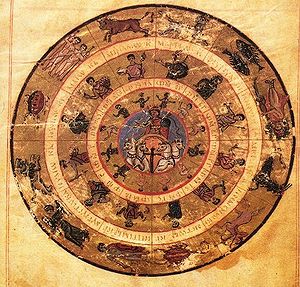 Helios in his chariot, surrounded by symbols of the months and of the zodiac. From Vat. Gr. 1291, the "Handy Tables" of Ptolemy, produced during the reign of Constantine V.
Helios in his chariot, surrounded by symbols of the months and of the zodiac. From Vat. Gr. 1291, the "Handy Tables" of Ptolemy, produced during the reign of Constantine V.
Intense debate over the role of art in worship led eventually to the period of "Byzantine iconoclasm."[48] Sporadic outbreaks of iconoclasm on the part of local bishops are attested in Asia Minor during the 720s. In 726, an underwater earthquake between the islands of Thera and Therasia was interpreted by Emperor Leo III as a sign of God's anger, and may have led Leo to remove a famous icon of Christ from the Chalke Gate outside the imperial palace.[49] However, iconoclasm probably did not become imperial policy until the reign of Leo's son, Constantine V. The Council of Hieria, convened under Constantine in 754, proscribed the manufacture of icons of Christ. This inaugurated the Iconoclastic period, which lasted, with interruptions, until 843.
While iconoclasm severely restricted the role of religious art, and led to the removal of some earlier apse mosaics and (possibly) the sporadic destruction of portable icons, it never constituted a total ban on the production of figural art. Ample literary sources indicate that secular art (i.e. hunting scenes and depictions of the games in the hippodrome) continued to be produced,[50] and the few monuments that can be securely dated to the period (most notably the manuscript of Ptolemy's "Handy Tables" today held by the Vatican[51]) demonstrate that metropolitan artists maintained a high quality of production.[52]
Major churches dating to this period include Hagia Eirene in Constantinople, which was rebuilt in the 760s following its destruction by an earthquake in 740. The interior of Hagia Eirene, which is dominated by a large mosaic cross in the apse, is one of the best-preserved examples of iconoclastic church decoration.[53] The church of Hagia Sophia in Thessaloniki was also rebuilt in the late 8th century.[54]
Certain churches built outside of the empire during this period, but decorated in a figural, "Byzantine," style, may also bear witness to the continuing activities of Byzantine artists. Particularly important in this regard are the original mosaics of the Palatine Chapel in Aachen (since either destroyed or heavily restored) and the frescoes in the Church of Maria foris portas in Castelseprio.
Macedonian Art
Main article: Macedonian art (Byzantine)The rulings of the Council of Hieria were reversed by a new church council in 843, celebrated to this day in the Eastern Orthodox Church as the "Triumph of Orthodoxy." In 867, the installation of a new apse mosaic in Hagia Sophia depicting the Virgin and Child was celebrated by the Patriarch Photios in a famous homily as a victory over the evils of iconoclasm. Later in the same year, the Emperor Basil I, called "the Macedonian," acceded to the throne; as a result the following period of Byzantine art has sometimes been called the "Macedonian Renaissance", although the term is doubly problematic (it was neither "Macedonian", nor, strictly speaking, a "Renaissance").
In the 9th and 10th centuries the Empire's military situation improved, and patronage of art and architecture increased. New churches were commissioned, and the standard architectural form (the "cross-in-square") and decorative scheme of the Middle Byzantine church were standardised. Major surviving examples include Hosios Loukas in Boeotia, the Daphni Monastery near Athens and Nea Moni on Chios.
There was a revival of interest in the depiction of subjects from classical mythology (as on the Veroli Casket) and in the use of a "classical" style to depict religious, and particularly Old Testament, subjects (of which the Paris Psalter and the Joshua Roll are important examples)
The Macedonian period also saw a revival of the late antique technique of ivory carving. Many ornate ivory triptychs and diptychs survive, such as the Harbaville Triptych and a triptych at Luton Hoo, dating from the reign of Nicephorus Phocas).
Comnenian Age
The Macedonian emperors were followed by the Komnenian dynasty, beginning with the reign of Alexios I Komnenos in 1081. Byzantium had recently suffered a period of severe dislocation following the battle of Manzikert in 1071 and the subsequent loss of Asia Minor to the Turks. However, the Komnenoi brought stability to the empire, (1081–1185), and during the course of the twelfth century their energetic campaigning did much to restore the fortunes of the empire. The Komnenoi were great patrons of the arts, and with their support Byzantine artists continued to move in the direction of greater humanism and emotion, of which the Theotokos of Vladimir, the cycle of mosaics at Daphni, and the murals at Nerezi yield important examples. Ivory sculpture and other expensive mediums of art gradually gave way to frescoes and icons, which for the first time gained widespread popularity across the Empire. Apart from painted icons, there were other varieties - notably the mosaic and ceramic ones.
Some of the finest Byzantine work of this period may be found outside the Empire: in the mosaics of Gelati, Kiev, Torcello, Venice, Monreale, Cefalù and Palermo. For instance, Venice's Basilica of St Mark, begun in 1063, was based on the great Church of the Holy Apostles in Constantinople, now destroyed, and is thus an echo of the age of Justinian. The acquisitive habits of the Venetians mean that the basilica is also a great museum of Byzantine artworks of all kinds (e.g., Pala d'Oro).
Palaeologan Age
Eight hundred years of continuous Byzantine culture were brought to an abrupt end in 1204 with the sacking of Constantinople by the knights of the Fourth Crusade, a disaster from which the Empire never recovered. Although the Byzantines regained the city in 1261, the Empire was thereafter a small and weak state confined to the Greek peninsula and the islands of the Aegean.
Nevertheless the Palaeologan Dynasty, beginning with Michael VIII Palaeologus in 1259, was a last golden age of Byzantine art, partly because of the increasing cultural exchange between Byzantine and Italian artists. Byzantine artists developed a new interest in landscapes and pastoral scenes, and the traditional mosaic-work (of which the Chora Church in Constantinople is the finest extant example) gradually gave way to detailed cycles of narrative frescoes (as evidenced in a large group of Mystras churches). The icons, which became a favoured medium for artistic expression, were characterized by a less austere attitude, new appreciation for purely decorative qualities of painting and meticulous attention to details, earning the popular name of the Paleologan Mannerism for the period in general.
Crete had been ruled by the Venetians since 1211, and the Cretan school of icon-painting gradually introduced Western elements into its style, and exported large numbers of icons to the West. After the fall of the Empire, Crete became the centre of Greek art, until it too fell to the Turks in 1669.
Legacy
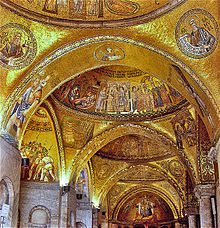 St Mark's Basilica in Venice, where imported Byzantine mosaicists were succeeded by Italians they had trained.
St Mark's Basilica in Venice, where imported Byzantine mosaicists were succeeded by Italians they had trained.
The splendour of Byzantine art was always in the mind of early medieval Western artists and patrons, and many of the most important movements in the period were conscious attempts to produce art fit to stand next to both classical Roman and contemporary Byzantine art. This was especially the case for the imperial Carolingian art and Ottonian art. Luxury products from the Empire were highly valued, and reached for example the royal Anglo-Saxon Sutton Hoo burial in Suffolk of the 620s, which contains several pieces of silver. Byzantine silks were especially valued and large quantities were distributed as diplomatic gifts from Constantinople. There are records of Byzantine artists working in the West, especially during the period of iconoclasm, and some works, like the frescos at Castelseprio and miniatures in the Vienna Coronation Gospels, seem to have been produced by such figures.
In particular, teams of mosaic artists were despatched as diplomatic gestures by emperors to Italy, where they often trained locals to continue their work in a style heavily influenced by Byzantium. Venice and Norman Sicily were particular centres of Byzantine influence. The earliest surviving panel paintings in the West were in a style heavily influenced by contemporary Byzantine icons, until a distinctive Western style began to develop in Italy in the Trecento; the traditional and still influential narrative of Vasari and others has the story of Western painting begin as a breakaway by Cimabue and then Giotto from the shackles of the Byzantine tradition. In general Byzantine artistic influence on Europe was in steep decline by the 14th century if not earlier, despite the continued importance of migrated Byzantine scholars in the Renaissance in other areas.
Islamic art began with artists and craftsmen mostly trained in Byzantine styles, and though figurative content was greatly reduced, Byzantine decorative styles remained a great influence on Islamic art, and Byzantine artists continued to be imported for important works for some time, especially for mosaics.
 Modern Orthodox mural from Israel using a depiction of the Nativity of Christ little changed in over a millennium.
Modern Orthodox mural from Israel using a depiction of the Nativity of Christ little changed in over a millennium.
The Byzantine era properly defined came to an end with the fall of Constantinople to the Ottoman Turks in 1453, but by this time the Byzantine cultural heritage had been widely diffused, carried by the spread of Orthodox Christianity, to Bulgaria, Serbia, Romania and, most importantly, to Russia, which became the centre of the Orthodox world following the Ottoman conquest of the Balkans. Even under Ottoman rule, Byzantine traditions in icon-painting and other small-scale arts survived, especially in the Venetian-ruled Crete and Rhodes, where a "post-Byzantine" style under increasing Western influence survived for a further two centuries, producing artists including El Greco whose training was in the Cretan School which was the most vigorous post-Byzantine school, exporting great numbers of icons to Europe.
Russian icon painting began by entirely adopting and imitating Byzantine art, as did the art of other Orthodox nations, and has remained extremely conservative in iconography, although its painting style has developed distinct characteristics, including influences from post-Renaissance Western art. All the Eastern Orthodox churches have retained highly protective of their traditions in terms of the form and content of images and, for example, modern Orthodox depictions of the Nativity of Christ vary little in content from those developed in the 6th century.
See also
- Icon
- Sacred art
- Book of Job in Byzantine Illuminated Manuscripts
Notes
- ^ S. Bassett, The urban image of late antique Constantinople (Cambridge, 2004).
- ^ C. Mango, "Antique statuary and the Byzantine beholder," Dumbarton Oaks Papers 17 (1963), 53-75.
- ^ O. Brendel, Prolegomena to the study of Roman art (New Haven, 1979).
- ^ B. Berenson, The Arch of Constantine; or, the decline of form (London, 1954).
- ^ J. Elsner, "The birth of late antiquity: Riegl and Strzygowski in 1901," Art History 25 (2002), 358-79.
- ^ E. Kitzinger, Byzantine art in the making (Cambridge, 1977).
- ^ J. Onians, "Abstraction and imagination in late antiquity," Art History 3 (1980), 1-23.
- ^ C. Mango, "Antique statuary," 65.
- ^ H. Belting, tr. E. Jephcott, Likeness and presence: a history of the image before the era of art (Chicago, 1994).
- ^ S. Bassett, The urban image of late antique Constantinople (Cambridge, 2004)
- ^ G. Fowden, "Constantine's porphyry column: the earliest literary allusion," Journal of Roman Studies 81 (1991), 119-31; F.A. Bauer, Stadt, Platz und Denkmal (Mainz, 1996).
- ^ T. Mathews, The early churches of Constantinople: architecture and liturgy (University Park, 1971); N. Henck, "Constantius ho Philoktistes?," Dumbarton Oaks Papers 55 (2001), 279-304 (available online).
- ^ B. Kiilerich, The obelisk base in Constantinople (Rome, 1998).
- ^ T. Mathews, The early churches of Constantinople: architecture and liturgy (University Park, 1971)
- ^ R. Krautheimer, Rome: profile of a city (Princeton, 2000).
- ^ J.-M. Spieser, Thessalonique et ses monuments du IVe au VIe siècle (Athens, 1984); S. Ćurčić, Some observations and questions regarding early Christian architecture in Thessaloniki (Thessaloniki, 2000).
- ^ D.H. Wright, The Vatican Vergil (Berkeley, 1993).
- ^ D.H. Wright, The Roman Vergil and the origins of medieval book design (Toronto, 2001).
- ^ I. Levin, The Quedlinburg Itala (Leiden, 1985).
- ^ W.F. Volbach, Elfenbeinarbeiten der Spätantike und des frühen Mittelalters (Mainz, 1976).
- ^ R. Delbrueck, Die Consulardiptychen und verwandte Denkmäler (Berlin, 1929).
- ^ E.C. Dodd, Byzantine silver stamps (Washington, 1961).
- ^ M. Almagro-Gorbea, ed., El disco de Teodosio (Madrid, 2000).
- ^ M. Maas, ed., The Cambridge companion to the age of Justinian (Cambridge, 2005).
- ^ Tr. H.B. Dewing, Procopius VII (Cambridge, 1962). English text online.
- ^ R.J. Mainstone, Hagia Sophia: archiecture, structure, and liturgy of Justinian's great church (New York, 1997).
- ^ K. Dark and F. Özgümüş, "New evidence for the Byzantine Church of the Holy Apostles from Fatih Camii, Istanbul," Oxford Journal of Archaeology 21 (2002), 393-413.
- ^ J. Bardill, "The Church of Sts. Sergius and Bacchus in Constantinople and the monophysite refugees," Dumbarton Oaks Papers 54 (2000), 1-11; T. Mathews, "The palace church of Sts. Sergius and Bacchus in Constantinople," in J.J. Emerick and D.M. Delliyannis, eds., Archaeology in architecture: studies in honor of Cecil L. Striker (Mainz, 2005).
- ^ G.H. Forsyth and K. Weitzmann, The monastery of St. Catherine at Mount Sinai: the church and fortress of Justinian (Ann Arbor, 1973).
- ^ A. Thiel, Die Johanneskirche in Ephesos (Wiesbaden, 2005).
- ^ F.W. Deichmann, Ravenna: Hauptstadt des spätantiken Abendlandes (Wiesbaden, 1969).
- ^ Website of the Eufrasiana Basilica project.
- ^ E. Wellesz, The Vienna Genesis (London, 1960).
- ^ G. Cavallo, Codex purpureus Rossanensis (Rome, 1992).
- ^ A. Grabar, Les peintures de l'évangéliaire de Sinope (Bibliothèque nationale, Suppl. gr. 1286) (Paris, 1948).
- ^ O. Mazal, Der Wiener Dioskurides: Codex medicus Graecus 1 der Österreichischen Nationalbibliothek (Graz, 1998).
- ^ A. Cutler, "Barberiniana: notes on the making, content, and provenance of Louvre OA. 9063," in Tesserae : Festschrift für Josef Engemann, Jahrbuch für Antike und Christentum, Ergänzungsband 18 (1993) 329-339.
- ^ D. Wright, "Justinian and an archangel," Studien zur spätantiken Kunst Friedrich Wilhelm Deichmann gewidmet, (Mainz 1986), III.75-79.
- ^ J. Haldon, Byzantium in the seventh century: the transformation of a culture (Cambridge, 1997).
- ^ L. Brubaker, "Elites and patronage in early Byzantium: the evidence from Hagios Demetrios in Thessalonike," in J. Haldon et al., eds., The Byzantine and early Islamic Near East: elites old and new (Princeton, 2004), 63-90.
- ^ C. Barber, “The Koimesis Church, Nicaea: the limits of representation on the eve of iconoclasm,” Jahrbuch der österreichischen Byzantinistik 41 (1991), 43-60.
- ^ G. Matthiae, Pittura romana del medioevo (Rome, 1987).
- ^ K.A.C. Creswell, Early Muslim architecture (New York, 1979); F.B. Flood, The Great Mosque of Damascus: studies on the making of an Umayyad visual culture (Leiden, 2001).
- ^ R. Leader, "The David Plates revisited: transforming the secular in early Byzantium," Art Bulletin 82 (2000), 407-27 (available online).
- ^ J. Leroy, Les manuscrits syriaques à peintures conservés dans les bibliothèques d'Europe et d'Orient; contribution à l'étude de l'iconographie des Églises de langue syriaque (Paris, 1964).
- ^ C. Nordenfalk, Die spätantiken Kanontafeln (Göteborg, 1938).
- ^ L. Brubaker, "Icons before iconoclasm?," Morfologie sociali e culturali in europa fra tarda antichita e alto medioevo, Settimane di Studio del Centro Italiano di Studi sull’ Alto Medioevo 45 (1998), 1215-54.
- ^ A. Bryer and J. Herrin, eds., Iconoclasm (Birmingham, 1977); L. Brubaker and J. Haldon, Byzantium in the iconoclast era (ca. 680-850): the sources (Birmingham, 2001).
- ^ D. Stein, Der Beginn des byzantinischen Bilderstreites und seine Entwicklung bis in die 40er Jahre des 8. Jahrhunderts (Munich, 1980). The story of the Chalke Icon may be a later invention: M.-F. Auzépy, “La destruction de l’icône du Christ de la Chalcé par Léon III : propagande ou réalité?", Byzantion 60 (1990), 445-492.
- ^ A. Grabar, L’iconoclasme byzantin: le dossier archéologique, 2nd ed., (Paris, 1984).
- ^ D. Wright, “The date of the Vatican illuminated handy tables of Ptolemy and of its early additions,” Byzantinische Zeitschrift 78 (1985).
- ^ R. Cormack, “The arts during the age of iconoclasm,” in A. Bryer and J. Herrin, eds., Iconoclasm (Birmingham, 1977).
- ^ U. Peschlow, Die Irenenkirche in Istanbul (Tübingen, 1977).
- ^ K. Theocharidou, The architecture of Hagia Sophia, Thessaloniki, from its erection up to the Turkish Conquest (Oxford, 1988).
Further reading
- J. Beckwith, Early Christian and Byzantine art (New Haven, 1993).
- R. Cormack, Byzantine art (Oxford, 2000).
- H.C. Evans, ed., Byzantium: faith and power (1261-1557) (New York, 2004).
- H.C. Evans, ed., The glory of Byzantium (New York, 1997).
- Sharon E. J. Gerstel and Julie A. Lauffenburger, ed., A Lost Art Rediscovered (Penn State, 2001) ISBN 0-271-02139-X
- C. Mango, ed., The art of the Byzantine Empire, 312-1453: sources and documents (Englewood Cliffs, 1972).
- K. Weitzmann, ed., Age of spirituality (New York, 1979).
- James, Elizabeth. Art and Text in Byzantine Culture (1 ed.). Cambridge University Press. ISBN 0521834090.
- Papadaki-Oekland, Stella. Byzantine Illuminated Manuscripts of the Book of Job. ISBN 2-503-53232-2 & ISBN 978-2-503-53232-5
External links
Wikimedia Commons has media related to: - Byzantium, Faith and Power, 1261-1453. Exhibition at the Metropolitan Museum of Art (2004).
- The Glory of Byzantium. Exhibition at the Metropolitan Museum of Art (1997).
- "Byzantine art", from Encyclopædia Britannica Online.
- "Byzantine art", from the 1911 Encyclopædia Britannica.
- Anthony Cutler on the economic history of Byzantine mosaics, wall-paintings and icons; at Dumbarton Oaks.
- BYZANTINE ICONS AND MOSAICS
- Byzantine Churches in Constantinople
- Contemporary Byzantine art
Categories:- Byzantine art
- Christian art
- Greek culture
Wikimedia Foundation. 2010.

